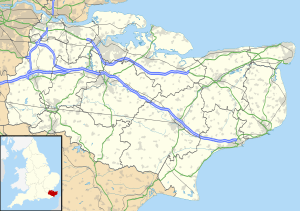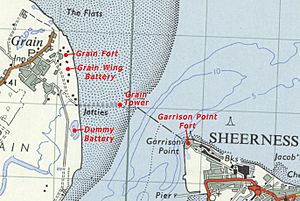Grain Fort facts for kids
Quick facts for kids Grain Fort |
|
|---|---|
| Grain, Kent, England | |
| Coordinates | 51°27′26″N 0°43′11″E / 51.4572°N 0.7197°E |
| Type | Fortification |
| Site information | |
| Owner | St James, Isle of Grain Parish Council |
| Condition | Demolished above ground |
| Site history | |
| Built | 1861–68 |
| Built by | United Kingdom |
| In use | 1868–1956 |
| Materials | Concrete, granite, brick |
| Demolished | 1960s |
Grain Fort was an old army fort built near the village of Grain, Kent. It was constructed in the 1860s. Its main job was to protect where the River Medway and River Thames meet. This was important because Britain and France were not getting along well at the time.
The fort's location was very strategic. Its powerful guns could help protect the nearby Grain Tower and Garrison Point Fort. These other forts were across the Medway at Sheerness. Over the years, Grain Fort was changed many times. Its guns were also made stronger and more modern. The fort was finally closed down in 1956. This happened when the UK decided to stop its coastal defence program. Most of the fort was then taken down. Today, you can still see parts of it. These parts are now part of a coastal park.
Contents
Why Was Grain Fort Built?
Grain Fort was built because Britain and France were in a "naval arms race." This means both countries were building bigger and better warships. Britain's old forts were not strong enough anymore. They had been built during the Napoleonic Wars, many years before.
New warships were much faster and had powerful, accurate guns. These new ships made the old forts useless. The River Thames was especially important to protect. It was a major trade route for Britain. Many important navy sites were also along the Thames. These included places where food was stored for the navy, weapon factories, and shipyards.
The Royal Commission's Plan
To deal with this threat, the government created a group called the Royal Commission on the Defence of the United Kingdom. In 1860, they released a big report. It suggested that many old forts should be updated or rebuilt. They also said new forts were needed in important places along the coast. About 70 new forts and gun batteries were built around England because of this report.
Before Grain Fort, there was already a gun battery called Grain Tower. It was built between 1848 and 1855. But new, powerful guns came out soon after it was finished. This made Grain Tower old-fashioned almost immediately. The 1860 report suggested making Grain Tower a stronger, fully enclosed fort. But this idea was too expensive. So, they decided to build a new fort on land at Grain instead. They also upgraded the existing fort at Garrison Point.
How Grain Fort Was Built
Grain Fort was built between 1861 and 1868. It had a unique seven-sided shape. At first, it had thirteen open spots for guns. These gun spots were on top of a large earth mound. Underneath the mound were rooms for storing ammunition and connecting tunnels.
In the middle of the fort was a semi-circular brick building. This building was the barracks, where the soldiers lived. It was also designed to be defended. It had small openings for soldiers to fire muskets. The back of the building, where the main entrance was, also had battlements. These were for protecting defenders if an enemy attacked from behind.
There was a ditch in front of the barracks. This ditch had four special structures called caponiers. These caponiers guarded the corners of the ditch. Soldiers could get to them through passages under the fort. An inner ditch around the barracks also had more caponiers. These led to the earth walls and into the barracks. A bridge also connected the barracks to the main gun platform.
Grain Fort's History
Grain Fort first had 13 heavy guns. These included six 11-inch guns, four 9-inch guns, and three 64-pounder guns. By the late 1800s, these were replaced with much stronger guns. These new guns included two 9.2-inch and two 4.7-inch guns. The number of gun spots was reduced to five by 1895.
The fort was still used during the Second World War. It was changed again during this time. Its two 6-inch defence guns were put inside bomb-proof shelters. New spots for controlling gun fire were also added. There were also spigot mortars at each end of the gun platform.
In 1956, Grain Fort was no longer needed. Five years later, it was sold to the local council. The buildings above ground were then taken down.
Other Nearby Batteries
To make the fort's firepower even stronger, two more gun batteries were built nearby. These were Grain Wing Battery, built between 1890 and 1895. It was about 50 meters south of Grain Fort. The other was Dummy Battery, built between 1861 and 1868. It was about 1 kilometer south of the fort. Neither of these batteries was used for very long. They were later disarmed and used for other things. Both were also closed down and sold along with Grain Fort.
What Grain Fort Looks Like Today
Not much of Grain Fort can be seen above ground now. The barracks building was demolished. The areas where the surface buildings once stood are now filled with rubble. However, the fort's earth walls and some brick parts still remain. A path now connects the concrete areas where the guns used to be.
The front caponiers, which were in the ditch, are buried but mostly still there. Tunnels and ammunition storage rooms still exist underground. Some people who explore old places have visited them. Many of the original fittings are still reported to be inside.
The fort's site is now part of the Isle of Grain Coastal Park. A group called the Friends of the Coastal Park helps manage it. The park is owned by St James Parish Council. The fort is also part of a special protected area. This area was set up in 1976 to protect the "coastal artillery defences on the Isle of Grain."




